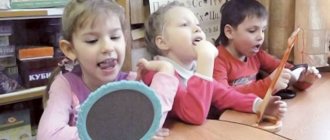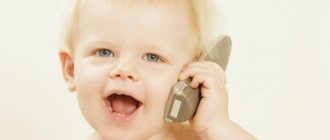Height and weight of a 1.5 year old child, data from domestic pediatricians
| 1 year 6 months | Bottom line | Upper limit |
| Boys' weight, kg | 10,2 | 13,0 |
| Girls' weight, kg | 9,8 | 12,2 |
| Boys' height, cm | 78,4 | 85,9 |
| Girls' height, cm | 77,1 | 84,5 |
| Boys' head circumference, cm | 46,6 | 50,2 |
| Head circumference of girls, cm | 45,8 | 49,0 |
| Boys chest circumference, cm | 47,4 | 53,9 |
| Girls chest circumference, cm | 47,8 | 52,9 |
What problems may arise
By 18 months, the baby should be able to walk without support, but some children start walking too late; in any case, the child should already be taking confident steps.
If the child still has not begun to speak his first words, it is worth contacting a specialist, since normal physical development at one and a half years includes the pronunciation of a certain number of words.
In order for a child to develop normally at 18 months, proper care, constant attention and daily developmental activities are necessary.
Share on social media networks
Height and weight of children aged 1.5 years WHO data
| 1 year 6 months | Bottom line | Upper limit |
| Boys' weight, kg | 8,8 | 13,7 |
| Girls' weight, kg | 8,1 | 13,2 |
| Boys' height, cm | 76,9 | 87,7 |
| Girls' height, cm | 74,9 | 86,5 |
| Boys' head circumference, cm | 44,7 | 50,0 |
| Head circumference of girls, cm | 43,5 | 49,0 |
At the age of one and a half years, a child:
- finally masters the spoon and cup;
- He prefers to eat himself, although he can cope (without spilling or spilling) only with thick pureed food.
When to teach a child to talk
Children do not start speaking all at once, as if by magic.
Some quickly pick up new words and begin to speak before one year, for some it takes much longer, since everyone has their own pace of development. Situations are considered normal when a child does not speak very well at 2.5 or 3 years old. If it is clear that the child is mastering new words and constructions, but is just doing it more slowly than some of his peers, everything is fine. If you are concerned about this issue, then you can always consult with a pediatrician and speech therapist, rather than tormenting yourself with questions and your child with an unreasonable burden in learning speech.
Cognitive development of a 1.5 year old child
Difference between objects in shape, size, color: Oriented in two forms (ball-cube, cube-brick); finds at the request of an adult. Selects an object of the same shape as in the sample. Begins to select a geometric object to the corresponding shaped hole on the edge of the aid (by applying it). Oriented in two sizes (large and small); finds after the show, at the request of an adult. Assembles a pyramid of two contrasting rings in size; after the show. Focuses on two or three colors. Finds a toy of the same color as the adult asks (shows). Leaves zigzags, dashes, ovals, straight lines with a pencil or felt-tip pen on paper.
Game actions: Turns the pages of books (“reads”). He rolls a stroller in front of him. He pulls the toy behind him by the string. Performs (displays) one or two frequently observed actions in the game (feeds, combs the doll’s hair):
- according to an adult's demonstration,
- at the request of an adult,
- in an independent game.
Uses substitute items in the game. Performs the same actions with them as with real objects. Acts on items in the game depending on their purpose. Imitates two or three play actions of peers. Shows intelligence: substitutes something, climbs in, uses an additional object to get the needed thing.
How to help your child with further development
- At this age, it is time to introduce the child to the colors and shapes of objects; you can name the color and ask the baby to point to it; together with the child, you can arrange toys by color;
- cubes and pyramids must be in a child’s arsenal, as they contribute to the development of fine motor skills;
- master drawing lessons with your child;
- You can give your child soft plasticine for modeling;
- most often, the child himself already shows the toys that are interesting to him, you should not ignore his desire, play with him those games that are really interesting to him;
- read books to your baby;
- Be with him always, this is the most important contribution to development.
Social and emotional development of a child at one and a half years old
Emotionally balanced, calm business state during the day. Socially significant gestures and facial expressions (“regrets”) appear:
- by show,
- at the request of an adult,
- rarely on their own initiative in response to a familiar situation.
Reacts to the emotional tone of an adult’s voice (imitates joyful or noisy exclamations). Imitates an adult’s emotional attitude to the situation (“sorries”, “empathizes”). Easily switches (transitions) from one emotional state to another (gets upset, calms down). Distracted. Cries, expresses anxiety when the routine or usual conditions are violated. Interested in the actions of other children. Shows negativism in relationships with peers (does not give up his toy, takes it away). Attracts the attention of a close adult with emotionally charged exclamations, facial expressions, movements or crying, and takes the hand. I'm glad to communicate with adults. Shows great interest in their activities. Cries when parting with mom, gets bored for a while. He is interested in independent actions with toys and enjoys his own successes. Distressed by inability (refuses to act). Reacts differently to different melodies, literary words (melody of poetry). Enjoys repeating familiar movements to music.
Daily regime
Dream.
At the age of 18 months, the child sleeps less than before - approximately 14 hours a day. The bulk of the allotted time (10-11 hours) is spent sleeping at night, and the child sleeps during the rest of the hours during the day. As a rule, there is only one nap during the day, but some babies still go to bed twice during the day.
Walks.
It is recommended to go for walks several times a day, at least once. If the weather permits, you can walk as much as the child and parents want; in particularly windy or rainy weather, it is better to stay at home.
Nutrition.
Meals are set to five times a day. It is not recommended for a child to fast for more than four hours; meals should be taken at approximately the same time. If your baby has not yet been weaned, now is the time to start this process. New foods appear in the child’s diet, the diet becomes more varied, but it is still worth abstaining from harmful foods.
If the child is bottle-fed, or you are weaning him from the breast, special attention should be paid to the formula; it must meet the child’s needs. An excellent option is to feed on goat milk Kabrita 4. The mixture has a balanced composition and is intended for children from 18 months. In addition, the Kabrita line includes purees, which will also be an excellent option for diversifying your baby’s diet.
Speech development of a 1.5 year old child
Speech comprehension: Shows body parts when asked by an adult. Generalizes toys and objects by appearance, regardless of size or color. Points to them at the request of an adult. The conceptual vocabulary increases: understands the meaning of many sentences. Performs familiar household actions at the request of an adult (put it down, carry it, cut it, etc.).
Active speech (pronounces up to 40 facilitated words): Pronounces simple words (correctly and individually facilitated). Uses words in moments of special interest. Answers the questions: “Who (what) is this?” (in a real situation and according to the picture). Seeks to connect two words into a sentence. Easily imitates frequently heard words and phrases of an adult. Speech is accompanied by facial expressions, gestures, movements, eye contact (meaning an additional word).
Speech development calendar for a young child
Early age is considered a very important period in a child's life.
This is the time of the most stormy and rapid changes in the mental and physical development of the baby; the child takes his first steps, learns to speak, begins to use gestures and other communicative means.
3 weeks - 1 month - a cry appears, indicating emotional discomfort, pain or hunger. When physically stressed, the child grunts, making the sounds “a”, “e”.
2 - 3 months : the child begins to hum, he pronounces simple sounds - “a”, “u”, “s”, sometimes in combination with “g”. This is an important stage in the development of speech in young children.
4 - 6 months - makes high-pitched melodious sounds, exclamation sounds, reacts with joyful sounds to the faces of loved ones.
6 - 9 months - babbling, he repeats the same syllables (“ma-ma-ma”, “ba-ba-ba”. “dya-dya-dya”, “gu-gu-gu”).
9 – 11 months – the baby begins to imitate the sounds of adults’ speech.
11 – 14 months – the first meaningful words “mom”, “dad”, “baba”, “uncle” appear, from 8 to 14 words. Correlates a word with an object
By the age of 2, a child’s vocabulary contains 100-200 words. He is already constructing a sentence of 2-3 words.
By the age of 3, the volume of the vocabulary increases to 1000 words due to the enrichment of the child’s life experience. Simple prepositions appear: in, on, under, for, with, at. The child remembers poems and children's songs.
By the end of 3 years, most children are able to construct sentences grammatically correctly, conduct dialogues, and tell what they saw and heard.
It is important to know:
Do not listen to advice from other parents whose children began to speak after 3 years, that the child will speak on his own. He will speak, the only question is what kind of speech it will be, its quality.
How to identify signs of speech disorders in a child?
By the end of 1 month the baby does not cry before feeding
By the end of 4 months, he does not smile when his mother talks to him, and does not gurgle.
By the end of the 5th month, does not listen to sounds and music
By the end of the 7th month, does not respond to voice intonation, does not recognize the mother’s voice due to the “revival complex”
By the end of 9 months there is no babbling, the child does not repeat sound combinations and syllables after an adult
By the end of 1 year, the child does not wave his hand when saying goodbye, or his head as a sign of denial. Does not utter a single word and does not follow simple instructions: “give”, “here”, “take”.
By the age of 1.5 years, does not show or name mom and dad, does not build a tower of cubes, does not differentiate sounding toys, does not use a pointing gesture.
By 2 years of age, does not show body parts, does not show mom and dad in photos, does not follow two-step instructions (go to the kitchen and put a plate on the table)
By the age of 2.5 years, he cannot distinguish between “big and small” and does not communicate with children.
By the age of 3, he cannot say his first and last name or tell a simple poem or fairy tale.
If this does not happen, there is a reason to turn to specialists.
Possible causes of speech disorders
- Viral and endocrine diseases of the mother, threat of miscarriage, trauma, toxicosis, low hemoglobin levels.
- Genetic abnormalities, hereditary predisposition.
- Unfavorable birth.
- Diseases suffered by a child in the first years of life
- Children who received low Apgar scores at birth
The exact cause of the violation is determined by the doctor, and the type of speech disorder is determined by the speech therapist.
What can parents do for successful speech development?
Speech is the highest mental function, therefore the period of intrauterine development of a child is very important. Parents need to take care of the development of speech even before his birth. It is important that the expectant mother receives only positive emotions .
Communicate more with your baby! Friendliness, a soft and calm voice, and grammatically correct speech are another important factor in speech development.
Often, children, using only a pointing gesture, get what they want. Teach your child to express his desires as fully as possible, to say new words and sentences.
Don't scold your child for mispronouncing words. This can provoke neurotic reactions. He will withdraw and stop speaking and learning new words.
Develop your baby's ability to listen and be attentive. Play games with him that promote the development of listening and hearing skills: “Listen, what’s ticking there? What’s that noise?” Let your baby learn to distinguish between speech and non-speech sounds (environmental sounds).
Teach fairy tales and poems with your child, because... by memorizing and repeating them, he learns new words, trains memory and attention.
It is important to know:
Speech disorders can be corrected - it is important not to waste time!
Author-compiler: Mikhnovich O.F. teacher-speech therapist
Peculiarities of manifestation of delayed speech development in children 4 years old
Features of delayed speech development in children 4 years old are slow or fast speech, blurred sounds, omissions of letters or syllables. Some children do not pronounce words at all or abbreviate them, replacing words with syllables, gestures, and facial expressions.
Characteristic symptoms:
- difficulties in formulating the question and in answering the question addressed to him; the answers are usually monosyllabic (“yes”, “no”, “there”, “here”);
- poor vocabulary - usually uses only those words that are used in everyday life;
- incorrect pronunciation of complex words;
- skipping syllables and sounds;
- lack of skills in composing a simple story or sentence based on a picture;
- replacing words that sound similar;
- There are no hissing or whistling sounds in the articulation, or the patient pronounces them incorrectly;
- replacing sounds with easier ones to pronounce;
- lack of criticism of speech errors in oneself and other people.









